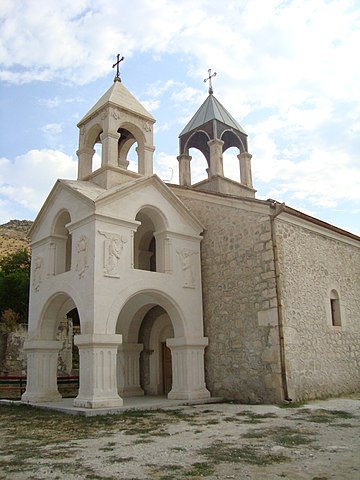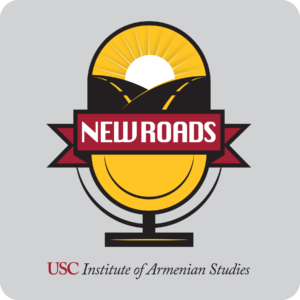
Prior to his long service as archbishop of Romania and Bulgaria (1960-2010), the late Dirair Mardigian had a relatively brief, but productive stint as leader of the Armenian church in Soviet Azerbaijan. At the time, with post-WWII relaxation of oppressive policies towards religion, the churches began to re-open throughout the USSR.
In a memoir titled “Life under the Sign of the Cross,” published in part by Aniv magazine in 2011, Mardigian offered unique insights into the life of the Armenian church, particularly in Baku where he was based between 1954 and 1960.
Born in 1930 in Beirut, Lebanon, Mardigian began his religious education at the Jerusalem seminary and continued it in Echmiadzin, after his family’s repatriation to Soviet Armenia in 1947. At the time, the church hierarchy of Echmiadzin was being newly reconstituted, since after the murder of Catholicos Khoren I in 1938, the Holy See remained closed until the election of Gevorg VI was permitted in 1945.
As Mardigian writes, in 1954 he was dispatched to Baku, initially as a form of punishment by the locum tenens Archbishop Vahan. Only in his 20s at the time, Mardigian made a strong impression on the local Armenians, as well as Azerbaijanis, particularly with his fluent Turkish. With the election of Catholicos Vazgen I in 1955, Mardigian was elevated to lead the Armenian congregations of Azerbaijan and Central Asia.
In 1956, on instructions from the Catholicos, Mardigian visited Karabakh to study the conditions of then shuttered Armenian churches there. He was accompanied by Karabakh-born monk serving in the Baku church, Ter-Hakob Mangasaryan.
“And so I went to Karabakh. I made it to the village of Vank at the foot of Gandzasar. For the night I stayed with the family of Misha, a local Armenian. People from the whole district, including director, chief doctor and others, having learned that a priest had arrived and wants to re-open the monastery, came to greet me. I told them about my life abroad – about Beirut, Lebanon, Jerusalem. Poor people they did not know anything about the rest of the world. At the time, they did not even know the significance of April 24, the Yeghern (the Armenian term for the genocide – Ed.).“
With the help from the locals, Mardigian reached Gandzasar. “At the top of the mountain I began to copy all the Armenian writings [on the monastery’s] stone walls. When and who built it, etc. I said a prayer. Here, [the early 18th century] Catholicos Yesai was buried. I served a liturgy for his soul.”
Following that trip, in a letter addressed to the chair of the Soviet Council of Ministers Nikolay Bulganin and dated May 12, 1956, Vazgen I noted that in Karabakh “there was only one church, and not in the Oblast’s center but in one of the remote villages.” He wrote that aside from Baku and Kirovabad (Ganja), no other churches were operational in Azerbaijan, including many still standing in Nakhichevan. He also noted that only four Armenian churches operated in Georgia and none in Central Asia, where there were also large Armenian communities. Specifically, Vazgen I petitioned for re-opening of the Tatev monastery in Soviet Armenia’s Goris district, Gandzasar in Karabakh and Surb Khach in Russia’s Rostov oblast.
“All these facts are known to foreign clergy and public figures who visit Soviet Armenia, and this creates an unfavorable impression with regard to the condition of the church in our country,” the Catholicos argued in the letter.
The Soviet government responded that the Church should seek Azerbaijani government’s permission. “Let’s see, holy father, how you will manage that,” Vazgen I told Mardigian, when relaying that message by telephone.

Dirair Mardigian. Photo via Aniv.ru
Mardigian reached out to the Azerbaijani official in charge of religion, comrade Mamedov, who told Mardigian to go back to Mardakert district, which included Gandzasar, and talk to local officials there. When he arrived in Mardakert, the local official in charge refused to meet him.
Realizing he was getting a runaround, Mardigian invited Mamedov to dinner and asked him to call the local official and tell him to satisfy his request. In apparent compromise, Mamedov agreed to reopening of a smaller church in the district center of Mardakert, rather than the more culturally significant Gandzasar.
Soon after, accompanied by priest Nshan from Kirovabad, Mardigian reopened the Mardakert church, the Surb Hovanes Mkrtich. This made a visit by Armenian Catholicos to Karabakh the following year possible.
On September 20, 1957, the Catholicos arrived in Baku by plane and proceeded to the Armenian church. After visiting in Baku, Vazgen I took a train to Kirovabad (historic Gandzak) that at the time had a community of 70,000 Armenians. According to Mardigian, the religious leader was touched by the emotional reception in both cities.
From Kirovabad the delegation went to Karabakh. The Catholicos visited Gandzasar, saw the ruins of the Armenian part of Shushi, burned down by Azerbaijani and Turkish forces in 1920, and spent the night in Stepanakert.
According to Mardigian, Vazgen I was hosted for dinner at the home of Sedrak Kocharyan, then a senior Karabakh Armenian official and the father of the future Artsakh and Armenian leader, Robert Kocharyan, who would have been a toddler at the time.









